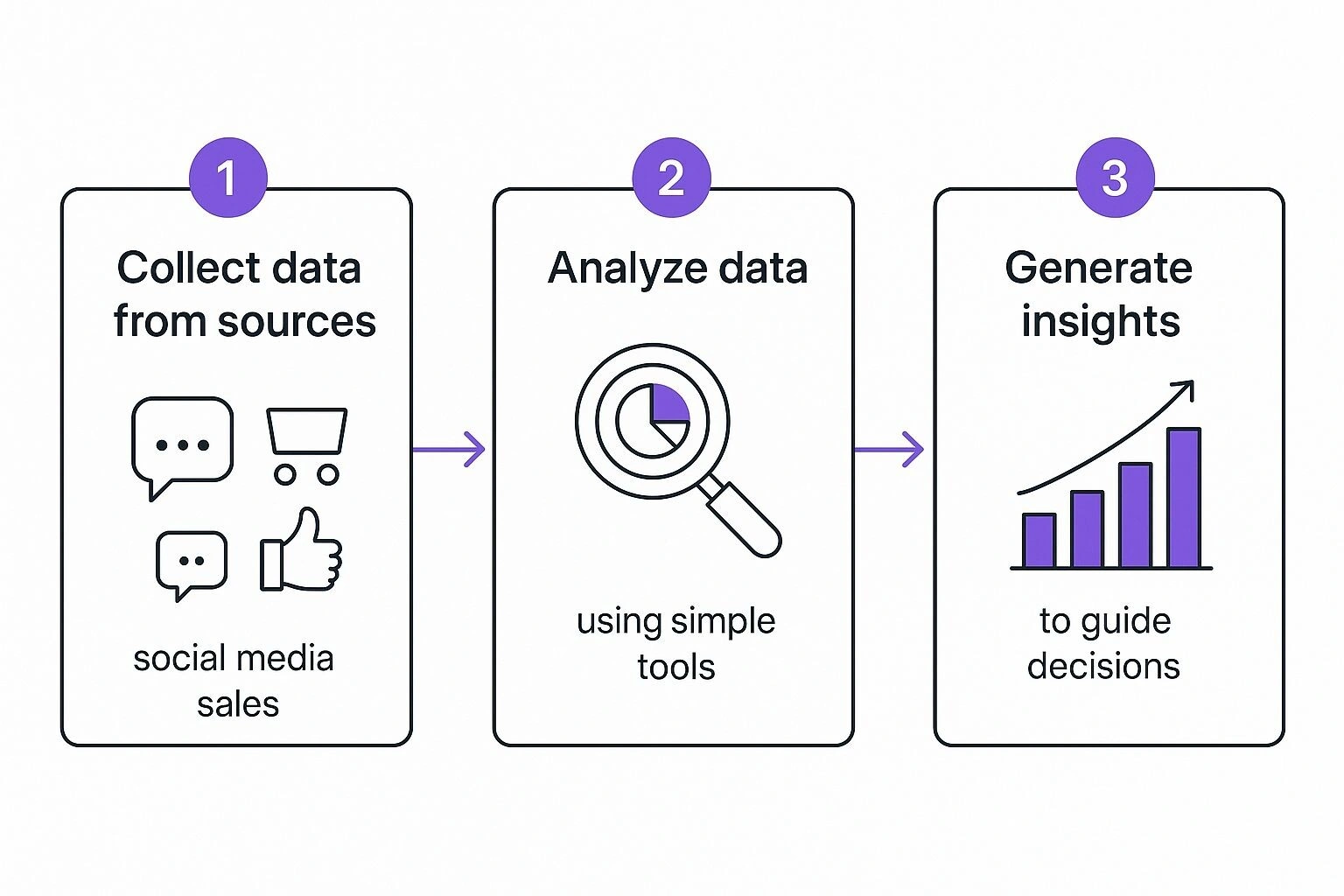What Is Business Analytics? A Plain English Guide
What is business analytics? Discover how data can help you make smarter decisions, understand your customers, and grow your business with confidence.

he term ‘business analytics’can sound a bit… intimidating. You might be picturing teams of data scientists in some high-tech lab, but I promise you, the reality is much more down-to-earth.
So, What Is Business Analytics, Really?
Business analytics is just the process of using the data your business already has to make smarter, faster, and better decisions. Seriously, that’s it. It’s about looking at all the information you’re sitting on—sales figures, website clicks, customer feedback, those comments on your socials—and finding the stories hidden inside.

Think of it like turning a messy pile of Lego bricks into a clear set of instructions. A road map that shows you what’s working, what isn’t, and where your next big opportunity might be hiding. The truth is, you’re probably already doing a basic version of it without even realising.
From Gut Feeling to Solid Fact
Every time you review last month’s sales to decide what to promote this month, you’re using analytics. The real goal here is to move beyond relying purely on gut feelings and start making choices based on solid evidence. It’s the difference between thinking your customers love a certain product and knowing they do because the numbers back it up.
This is a subtle but powerful shift. It’s all about effectively transitioning from data to decisions that drive genuine growth and efficiency.
It’s a bit different to other data stuff you hear about, though. Business analytics is laser-focused on business outcomes and solving commercial problems. We dive a bit deeper into the nuances in our guide here: https://osher.com.au/blog/what-is-data-analytics/.
Why It Matters More Than Ever
In today’s competitive Australian market, making smart decisions quickly is no longer a luxury. It’s a necessity. This is where business analytics really shines, helping businesses refine everything from their daily grind to their big-picture strategic planning.
The global business analytics market is projected to skyrocket to USD 196.5 billion by 2033. That’s a massive number, and it’s a clear signal that companies everywhere are waking up to its value.
This isn’t about becoming a data guru overnight. Don’t worry about that. It’s about learning to ask better questions and knowing where to look for the answers.
The real purpose of business analytics isn’t to drown you in charts and spreadsheets. It’s to give you the confidence to make your next move, knowing it’s backed by facts, not just hunches.
Ultimately, it helps you understand your business on a much deeper level by answering critical questions:
- What are your customers really doing? Not just what they say they’re doing.
- Where are the hidden bottlenecks in your processes? Those small frustrations that add up to big delays.
- Which marketing efforts are actually delivering a return? So you can pour more into what works and ditch what doesn’t.
Our goal is to demystify business analytics and show you that it’s a practical tool you can start using today. Not some complex technical thing reserved for experts.
Why Business Analytics Is Your Secret Weapon
Okay, so we’ve got a handle on what business analytics is. But let’s get to the real question… why should you actually care? This is where things get interesting.
Imagine knowing exactly which marketing campaign is bringing in your best customers, not just the most. Or being able to predict when you’ll need more stock before you run out during a sales rush. That’s the real power of analytics. It’s all about shifting from decisions based on gut feelings to choices backed by solid, cold, hard evidence.
Simply put, you start making smarter, faster, and more confident decisions.

Go Beyond Guesswork and Hunches
We’ve all been there. You launch a new service, and it feels like it’s going well. But is it really? Which customers are buying it? Are they new clients or just your existing regulars? Without the right data, you’re basically flying blind.
Business analytics is like flicking the lights on in a dark room. Suddenly, you see the full picture with absolute clarity. You’re no longer guessing what works; you know what works because the numbers are telling you the story. This shifts your whole approach from being reactive to proactive.
You stop putting out fires and start building fireproof systems. It’s a fundamental change in how you operate, moving from hoping for the best to planning for success.
This isn’t about chasing abstract figures on a dashboard. It’s about gaining a real, tangible competitive advantage in the real world.
Sharpen Your Competitive Edge
In any crowded market, the businesses that come out on top are the ones that understand their environment better than anyone else. Business analytics gives you that clarity. Think of it as your secret weapon for spotting opportunities your competitors are completely missing.
Here’s how that translates into a genuine advantage:
- Deeper Customer Understanding: You can finally move beyond surface-level stuff. Analytics helps you understand customer behaviours, preferences, and pain points, allowing you to create offers and experiences they genuinely value.
- Operational Excellence: Where are the hidden bottlenecks slowing you down? Analytics pinpoints inefficiencies in your processes, from supply chain kinks to workflow delays, so you can fix them and run a smoother, more profitable operation.
- Smarter Financial Decisions: You can forecast future revenue with far greater accuracy, manage inventory to cut down on waste, and point your budget towards the things that promise the highest return on investment.
Think of it like this: two businesses are sailing. One just lets the wind take them wherever it goes. The other is using weather charts, tide tables, and a compass to plot the most direct course. Which one do you think gets to their destination first?
Make Data-Driven Decisions a Reality
Ultimately, the biggest benefit is confidence. It’s the confidence to invest heavily in a marketing channel because you’ve seen the data on its stellar performance. It’s the confidence to launch a new product because your analysis has identified a clear gap in a market that’s just waiting for you.
This is what being “data-driven” truly means. It isn’t just a buzzword; it’s a culture. It’s about empowering your entire team to ask, “what does the data say?” before making any critical move.
Businesses that successfully embed this way of thinking find that it improves almost every single part of their performance. They become more agile, more efficient, and far more resilient to sudden market shifts. It’s not just about surviving… it’s about setting your business up to thrive.
Understanding the Analytics Process
So, what actually makes business analytics work its magic? Let’s peek under the bonnet for a moment. Don’t worry, we won’t get lost in a sea of technical jargon.
Think of it like brewing a great cup of coffee. First, you need quality beans—that’s your data. Then you have your specific method and equipment, like a pour-over or an espresso machine—that’s the analysis. The final result is a perfect coffee that kick-starts your day—those are the valuable insights that help your business grow.
It’s a logical flow. Not some mysterious, complex science.
This process of collecting, analysing, and acting on data is the engine of business analytics, as this simple flow shows.

As you can see, it’s a straightforward path from gathering raw information to making informed decisions that drive real results.
The Hunt for Good Data
First up, the ingredients. Your data. And the good news is, you’re probably sitting on a goldmine of it already. It’s often hiding in plain sight, in the tools and platforms you use every single day.
We’re not talking about complicated data lakes or anything like that. We’re talking about practical, accessible information.
- Your Accounting Software: This is a treasure trove. It tells you who your most profitable clients are, which services are selling best, and what your cash flow looks like over time.
- Your Website Analytics: Tools like Google Analytics show you where your visitors come from, which pages they love, and where they drop off. It’s like a blueprint of your customers’ online journey.
- Customer Surveys and Feedback: Direct feedback is pure gold. What do your customers love? What drives them crazy? This is the ‘why’ behind the numbers.
- Social Media Pages: Your social accounts reveal which content resonates with your audience, what questions they’re asking, and what the general vibe is around your brand.
The list goes on. The key is to start seeing these everyday tools not just as operational necessities, but as sources of critical business intelligence.
Making Sense of It All
Once you’ve gathered your ingredients, it’s time to start mixing. This is the analysis stage, where you turn raw numbers into a coherent story. You don’t need a supercomputer for this; honestly, a simple spreadsheet is often more than enough to get started.
The goal here is to spot patterns, trends, and outliers. For example, you might notice that sales always spike on the first Tuesday of the month. Why? Or maybe you see that customers who buy product A almost always come back to buy product B within three months. That’s a powerful insight right there.
For a deep dive on translating customer feedback into strategy, check out this guide on mastering survey data analysis. It’s a great resource for turning those raw responses into something genuinely useful.
The point of analysis isn’t to find every possible answer. It’s to find the one or two key insights that can make a genuine difference to your next decision.
This data-driven approach is becoming central to how Australian businesses operate. The Australian data analytics market was valued at around USD 1.46 billion recently and is projected to explode to USD 10.22 billion by 2030. That incredible growth shows just how vital this process has become for staying competitive.
From Insight to Action
This is the final, and most important, step. The moment you take that first sip of perfectly brewed coffee. It’s where you take the story you found in the data and use it to make a smart move.
An insight is useless if it just sits in a report. It has to lead to action.
- Insight: “Our website traffic from Facebook ads is high, but very few of those visitors make a purchase.”
- Action: Pause the Facebook ads and reallocate that budget to Google Search ads, which have a much higher conversion rate.
See how that works? It’s a simple, logical chain of events. You collect the data, find the story, and then use that story to write a better next chapter for your business. That, in a nutshell, is the analytics process.
Business Analytics in the Real World
It’s one thing to talk about theories and frameworks, but where the rubber really meets the road is in how it’s actually used. How does business analytics play out in the day-to-day of a real company?
Let’s move beyond the abstract concepts of “insights” and “data-driven decisions.” The real magic happens when you see analytics help a local business avoid a costly mistake or uncover a hidden gem of an opportunity.
We’re going to look at some real, relatable examples of how Aussie businesses are using analytics to get ahead. These aren’t just textbook scenarios; they’re grounded in the kinds of challenges you probably face every day. The goal is for you to see these stories and think, ‘Hang on… I could do that.’

From Cafes to Clicks: The Everyday Wins
You don’t need a massive data science team or a six-figure budget to start seeing results. The core ideas of business analytics scale down beautifully to even the smallest operations.
Take a local cafe in Melbourne. The owner assumes their smashed avo is the star player because it gets all the love on Instagram. But a quick dive into their point-of-sale data reveals something surprising: their humble bacon and egg roll is actually their most profitable item. By a lot.
- The Insight: The trendy, popular item isn’t the real money-maker.
- The Action: They give the bacon and egg roll a permanent, prominent spot on the menu and run a simple promotion. Sales for that item triple, lifting their overall profit without needing to find a single new customer.
That’s business analytics in its purest form. A simple question, easily accessible data, and a powerful, profitable outcome.
Boosting Online Sales with Smart Tweaks
Now, let’s scale up a little. An online clothing boutique in Sydney is getting plenty of traffic, but their conversion rate is flat. So many visitors are leaving without buying anything. Their gut feeling is that the prices are too high.
Instead of immediately slashing prices and hurting their margins, they look at their website’s click data. Using a simple analytics tool, they can see where people are clicking—and, more importantly, where they aren’t. They quickly realise almost no one is interacting with the main homepage banner promoting their new arrivals.
They were putting their best products front and centre, but the data showed that customers weren’t even looking in that direction. The analytics pinpointed the exact disconnect between their marketing efforts and what people were actually doing.
Armed with this insight, they redesign their homepage. The “Shop New Arrivals” button is made bigger, brighter, and moved to the middle of the page. Within a week, their conversion rate jumps by 15%. They didn’t need to cut prices or spend more on ads; they just made it easier for customers to find what they were looking for.
Getting Smarter on the Tools
It’s not just retail and hospitality that benefit, either. Consider a trade business—say, an electrician in Brisbane with a team of five. They’re constantly feeling stretched, driving all over the city, and wasting precious time and fuel.
The owner decides to analyse their job data from the past six months. By mapping out every job location and reviewing the travel times logged in their scheduling app, a clear pattern emerges. Two of their electricians are consistently crossing paths, driving from one side of the city to the other on the same day.
- The Insight: Job scheduling is geographically inefficient, causing wasted travel.
- The Action: They reorganise the daily runs, creating specific geographic zones for each electrician. This simple change cuts down travel time by 20%, slashes fuel costs, and allows the team to fit in one extra job per person, per day.
These examples show how analytics can solve real, practical problems. It can even help you see what’s around the corner. For those interested in how data can be used to forecast future trends, our introduction to understanding what is predictive analytics is the perfect next step to making your business even smarter.
Your First Steps into Business Analytics
Feeling inspired? Maybe a little overwhelmed about where to actually begin? That’s a completely normal reaction. It’s easy to look at the big picture and feel like you need a data science degree or a massive budget just to get in the game.
But you don’t. Not at all.
This is your practical, no-nonsense guide to dipping your toes in the water. We’re going to start small. Really small. The goal isn’t to build a complex analytics powerhouse overnight; it’s to build your confidence one small, meaningful win at a time.
Start with a Simple Question
Forget about big data and complex algorithms for a moment. The entire journey of business analytics begins with one simple, curious question about your own business. Something you’ve probably wondered about before but never had the time to properly look into.
Think about the questions that keep you up at night.
- Which of our services is actually the most popular with new customers?
- What day of the week do we get the most genuine enquiries?
- Where are most of our website visitors coming from?
Choose just one. The simpler, the better. This isn’t about solving every business problem at once; it’s about finding a single thread to pull on.
Your first step isn’t about data at all. It’s about curiosity. It’s about choosing a single, specific question that, if answered, would make your next decision just a little bit easier.
Once you have your question, the next steps become much clearer. You now have a target, a clear destination for your investigation.
Find the Data You Already Have
Okay, you’ve got your question. Now, where’s the answer hiding? The good news is that you’re almost certainly sitting on the data you need. It’s tucked away in the tools you use every single day.
Let’s say your question is, “What day of the week do we get the most enquiries?”. You just need to find where you track that information.
- Is it in your email inbox? You could manually count them.
- Is it in your CRM software? Most systems can generate a simple report on this.
- Is it through your website’s contact form? The form submissions will be time-stamped.
The tool doesn’t need to be fancy. A well-organised spreadsheet is one of the most powerful business analytics tools on the planet. Honestly. The key is to find the most direct path to the raw information.
Use Simple Tools to Find the Answer
Now for the fun part: finding the actual answer. This is where you connect your data to your question. Again, we’re keeping it simple.
- For website data: Google Analytics is a free, incredibly powerful tool that can tell you almost anything you need to know about your online visitors. It can feel a bit much at first, but a few tutorials will show you how to find basic reports.
- For sales data: Your accounting software or point-of-sale system likely has built-in reporting features. Spend an hour clicking around, and you might be amazed at what you can find.
- For everything else: A spreadsheet is your best friend. Export the data, create a simple table, and use the ‘Sort’ or ‘Filter’ function. That alone can reveal incredible patterns.
Remember, the goal here is not a perfect, multi-layered analysis. It’s just about getting a clear answer to your one simple question.
The growing demand for these insights is changing how Australian businesses operate. The local data analytics market was recently valued at around AUD 2.00 billion and is expected to climb to AUD 19.08 billion by 2034. Many are outsourcing these tasks to get real-time answers without the in-house headache, as you can see in these insights about data analytics services driving Australian business growth.
Build on Your Small Wins
Once you have your first answer, celebrate it! You just completed a full cycle of business analytics. You asked a question, found the data, and uncovered an insight.
Maybe you discovered that most of your enquiries come in on a Wednesday. What can you do with that? You could make sure you’re fully staffed on Wednesdays to handle the volume. Or perhaps you could run a small social media promotion on Tuesdays to get ahead of the curve.
The specific action doesn’t matter as much as the process itself. You’ve just proven that you can make a more informed decision. The quality of your data is hugely important here, of course. For more on that, you might be interested in our guide on the fundamentals of data quality management.
Now… what’s your next question?
A Few Common Questions About Business Analytics
We’ve covered a lot of ground, so it’s only natural if you have a few questions bubbling up. That’s a great sign—it means you’re already thinking about how these ideas apply to your own business.
Let’s clear the air and tackle some of the most common questions we hear. Think of this as a quick Q&A to help you move forward with confidence.
What’s the Real Difference Between Business Analytics and Business Intelligence?
This is the big one. It’s easy to see why people get these two mixed up, as they’re often mentioned in the same breath. But there’s a simple way to separate them.
Think of it like driving a car. Business intelligence (BI) is your dashboard. It tells you what’s happening right now and what has already happened. Your current speed, fuel level, and the distance you’ve travelled. It’s all about presenting historical and current data in a digestible format. BI answers the question, “What happened?”
Business analytics (BA), on the other hand, is your GPS and the engine warning light. It’s not just showing you where you are; it’s trying to predict what lies ahead and explain why things are happening. The GPS suggests the best route to avoid traffic (predictive), while the warning light alerts you to a funny noise because of a specific issue (diagnostic). BA answers the questions, “Why did this happen?” and “What will happen next?”
BI gives you the facts. BA helps you understand the story behind those facts and write the next chapter. They work together, but they play very different roles.
So, while BI is brilliant for building reports and monitoring performance, business analytics is what you turn to when you need to dig deeper, ask forward-looking questions, and shape your strategy.
Do I Need to Be a Tech Whiz to Do This?
Honestly? No. Not at all. The idea that you need to be a coding genius or a statistician to get value from business analytics is a complete myth. While those deep technical skills are fantastic for highly complex projects, they are absolutely not a prerequisite for getting started.
In reality, the most important skills are ones you likely already have.
- Curiosity: The simple desire to ask “Why?” and not settle for a surface-level answer.
- Critical Thinking: The ability to look at a number and consider what it truly means in the context of your business.
- A Bit of Patience: You won’t find every answer in five minutes. Sometimes, the real insight comes from looking at the problem from a few different angles.
You don’t need to know how to build a sophisticated statistical model from scratch. You just need to know how to ask a good question and where to look for the answer. Often, that’s just a matter of knowing your way around a spreadsheet.
Do I Have to Spend a Fortune on Fancy Software?
Definitely not, especially when you’re just starting out. The market is filled with incredibly powerful—and often very expensive—analytics platforms. While they have their place in large enterprises, they’re total overkill for most businesses just dipping their toes in the water.
You can start making a real impact with tools that are probably already on your computer.
- Spreadsheets (like Excel or Google Sheets): Never underestimate the power of a well-organised spreadsheet. They are perfect for sorting, filtering, and visualising small to medium-sized datasets to spot initial trends.
- Google Analytics: If you have a website, this free tool is non-negotiable. It provides a massive amount of information about your visitors and how they interact with your site.
- Your Existing Software: Most modern accounting, CRM, and email marketing platforms have built-in reporting dashboards. Take an hour to explore them—you’ll likely be surprised by the insights they offer right out of the box.
The key is to start with what you have. Master the basics and prove the value of analytics to yourself first. You can always invest in more advanced tools later, once you know exactly what problems you’re trying to solve.
Ready to move beyond spreadsheets and truly automate your data processes? Osher Digital builds custom AI-driven solutions that connect your systems, clean up your data, and deliver the insights you need to make smarter decisions, faster. Discover how we can help you scale your operations by booking a discovery call with us.
Jump to a section
Ready to streamline your operations?
Get in touch for a free consultation to see how we can streamline your operations and increase your productivity.